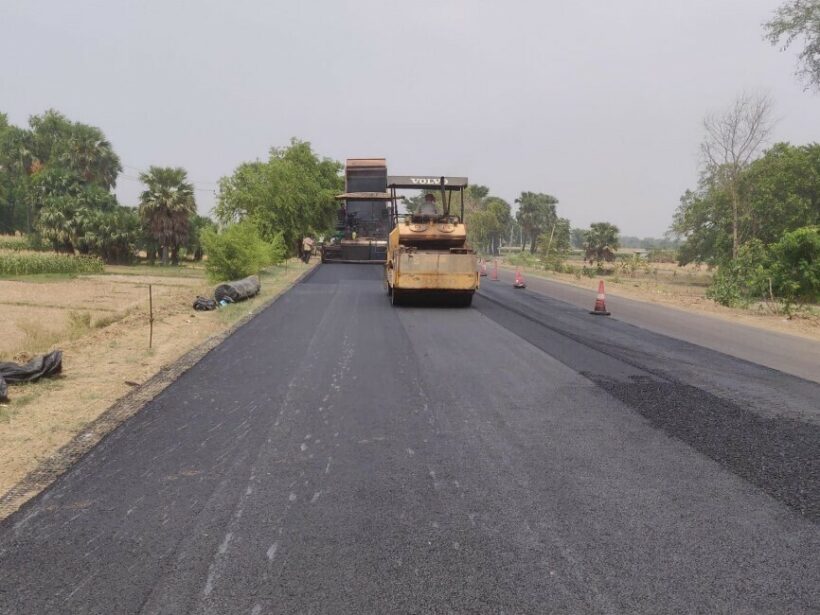Asphalt reinforcement
Asphalt reinforcement: definition, use, and type
Asphalt reinforcement is the process of reinforcing the layers of asphalt pavements to improve the service life of the road. Asphalt can be defined as the mixture of a petroleum biproduct with aggregate such as sand, gravel and a binder such as bitumen. It’s the final surface which is applied to a paved road, using a paving machine. As such, asphalt is available in different types of mixes and grades such as HMA, or Hot Mix Asphalt, Cold Mix Asphalt, Warm Mix, Porous Asphalt among others, depending on the type of specification needed for the pavement. Asphalt reinforcement is needed to mitigate or delay the onset of reflective cracking in pavements. By reinforcing such pavements, we can minimize the appearance of cracks, reduce rutting, reduce the impact of fatigue, and propagation of cracks from surface to the bottom. The types of reinforcement vary from project to project, and depends on the type of roads being built. This includes the use of geogrids, fiber, glass, steel and various other construction materials. Note: often the definition of asphalt and its ingredients may vary from country to country and as such we refer to the most universally accepted definition of asphalt. Asphalt reinforcement allows for enhanced structural integrity which in turn improves the life of the road, and the long-term costs of maintaining infrastructure. While pavement degeneration is an accepted reality of asphalt paved roads, designing roads that account for resistance to cracking, fatigue and rutting means making inherent design choices for better, long-lasting materials with improved outcomes.
Common reasons why asphalt reinforcement is needed:
Asphalt paved roads are created for areas such as highways, access roads, airports, parking areas: essentially, areas with vehicular traffic with varied weights, and volume. Although the need for roads is universal, as part of human development, the soils in which they get constructed vary hugely. Each time a road is created, a company is required to conduct soil analysis which investigates the soil composition, the amount of load it bears, the effect of repetitive vehicular stresses, or soil compaction, soil drainage, i.e. the amount of water it can allow to pass without changing shape, or stagnating, soil swelling or shrinkage, i.e. the extent to which soil particles expand or shrink due to moisture. Each of these aspects then in turn determines the thickness of the pavement, its inherent capacity to carry a specified amount of vehicular load, and the factors which may cause the pavement or road to collapse internally; also called pavement failure, or soil erosion. Once these factors are understood through a number of lab based tests, civil engineers set about designing the number of layers needed to construct the road, materials for the layers, reinforcement layers, in-fill material, and other design choices to help build the best type of road, based on where and how it will be used. Asphalt reinforcement is therefore a preventive action undertaken to delay or defer the imminent crack road development over prolonged exposure to weight, temperature changes, and moisture changes from the surface. Each soil type comes with its own inherent load bearing capacity, shear strength, and Atterberg limits, among other measures of soil strength. Thus, the reinforcement helps address topographic deficiencies in the terrain before it causes problems, after iterative stresses. Cracks on pavement surfaces are a maintenance issue with a knock-on effect on pavement life, which further affects the cost of the project. The first consequence of surface cracking is that it allows water to enter pavement structure, leading to a weakened foundation. This, in turn, also causes travel at the edge of cracks, gives rise to overall surface roughness leading to an uncomfortable driving experience, and even more imbalanced vehicular loads, and generates vibrations and noise. Overall, while surface cracks cannot be avoided, they can be delayed by reinforcement of the asphalt at the time of installation and in factoring these needs at the design stage itself.
How do geogrids help with asphalt reinforcement?

Geogrids are polymer-based layers with apertures which are placed between aggregates to provide lateral support. Geogrids are of three types: uniaxial, biaxial and triaxial. These geogrids are parallel grids which confine the aggregate or subgrade material and secure it in place. By confining the soil on a horizontal plane, the geogrid allows for friction between the soil particles, while distributing the load of the subgrade material over its joints. Since geogrids inherently have a high tensile strength both in longitude and transverse directions, in some cases of up to 800Kn/meter, they are able to distribute the load from the overlying layer more evenly across a wider area and improve the subgrade’s strength. These three effects, i.e., tensile strength, load bearing capacity, and reduced vertical stress in turn help stabilize the whole structure of the pavement by improving the shear strength, resistance to deformation of the soil, and minimizes the settlement and deformation of the soil itself under repetitive stress. Since geogrids can be used to improve the strength of the subgrade, the use of them as soil reinforcement layer works across weak soils too, which inherently cannot support heavy loads. Further, since geogrids also stabilize the overall structure, it leads to a reduced amount of in-fill material, reduced thickness of pavement, and overall cost savings; right from the start of the project, to the lifecycle of the pavement since it addresses inherent geotechnical challenges.
